Brawl Stars Championship Guide: Win the Championship Challenge
Updated On: November 12, 2025 by Aaron Connolly
Understanding the Brawl Stars Championship
The Brawl Stars Championship runs for eight months and features several stages. Everything starts with 72-hour in-game challenges, then moves to online qualifiers, and finally leads to live finals with over £750,000 in prizes.
If you want to compete, you really need to know how the format works, what game modes rotate in, and which rules or requirements apply.
How the Tournament Works
Supercell organizes this as their official mobile esports event. Every February, a new season kicks off with eight months of qualifying events.
You get your shot through 72-hour Championship Challenges, which pop up monthly. Think of these as the first big test for anyone who wants to get serious.
Tournament Flow:
- Monthly Championship Challenges (72 hours each)
- Online qualifiers (weekly after challenges)
- Regional championships
- World finals
To complete a Championship Challenge, you need 15 wins across five game modes. Four losses and you’re out—unless you buy extra lives with gems.
Win matches, and you’ll grab Starr Drops right away. The top players move on to the next round, where prize money is on the line.
Since it’s all on mobile, you can play pretty much anywhere. Maybe that’s why Brawl Stars keeps growing so fast in the esports world.
Stages and Format Overview
Each Championship Challenge breaks down into five fixed stages. You need three wins per stage to move forward, and each one uses a specific map and mode.
Stage Breakdown:
- Gem Grab – Hard Rock Mine
- Brawl Ball – Triple Dribble
- Heist – Safe Zone
- Hot Zone – Dueling Beetles
- Knockout – Belle’s Rock
You get a random Starr Drop for every victory. If you hit all 15 wins, you’ve beaten the challenge.
The later stages get tough. Knockout mode in particular punishes every mistake, since eliminations are permanent each round.
Maps do rotate now and then, but you’ll always see these five modes. That gives you a chance to really practice and refine your approach.
When you qualify, you’ll enter online tournaments. These use a best-of-three system with draft picks, which feels a lot more like classic esports events.
Key Rules and Eligibility
Anyone with a Brawl Stars account can jump into Championship Challenges. No trophy minimums or level requirements—just show up.
Basic Requirements:
- Active Brawl Stars account
- Reliable internet
- Be available during the 72-hour window
You can play solo and get matched with randoms, but pre-made teams usually have a big advantage.
Critical Rules:
- Four losses and you’re out
- You can buy more lives with gems
- Every challenge lasts exactly 72 hours
- No account sharing, period
For online qualifiers, you’ll need to be at least 16 and meet regional residency rules.
Prize events require you to verify your identity and fill out tax forms. Supercell handles all that once you qualify.
Championship Challenges reset every month, so if you miss one, no worries. You can always try again next month—great for casual players who just want to dip their toes in.
Joining and Competing in the Championship
If you want to get into the Brawl Stars Championship, you need to follow a few steps and build some solid teamwork. You’ll register through in-game challenges, form a team of three, and keep an eye on tournament news.
Registration and Qualification Steps
The Brawl Stars Championship uses a structured qualification system that starts with those in-game challenges. These run for 72 hours, once a month, from February onward.
Championship Challenge Format:
- Get up to 15 wins across five stages
- Each stage has specific maps and modes
- You’re out after a set number of losses
- Rewards include Starr Drops and qualification points
When the event goes live, just open the main menu and look for the Championship Challenge tile.
Qualification Requirements:
- Hit the minimum win count in the challenge
- Keep your account active
- Finish within the 72-hour window
- Meet regional rules
If you do well, you’ll move on to online qualifiers. These happen the week after each challenge and the matches get a lot tougher.
Forming Competitive Teams
You’ll need a team of three players who really click together. Teamwork makes a huge difference—randoms usually don’t cut it when things get serious.
Essential Team Roles:
- Aggro player: Pushes up and handles close-range brawlers
- Support player: Runs utility brawlers and helps the team
- Flex player: Swaps roles and brawlers as needed
Practice together before you jump into championship matches. Make sure you’re comfortable with all the main modes like Gem Grab, Heist, and Brawl Ball.
Team Communication Tips:
- Use voice chat—it really helps
- Call out enemy locations and weak targets
- Time your supers together for big plays
- Build set strategies for every map
The best teams drill their comps and strategies for weeks. It’s better to master a few strong setups than to try everything at once.
Staying Updated on Tournament Updates
Schedules and rules change a lot during the season. If you miss an update, you could miss out on a chance to qualify.
Key Information Sources:
- Official Brawl Stars social media
- In-game news and announcements
- Brawl Stars Esports website and streams
- Forums and Discord servers
The championship splits into four phases, and each one tweaks the rules. Map pools, banned brawlers, and format shifts are all pretty common.
Important Dates to Track:
- Challenge start/end times (always 72 hours)
- Online qualifier sign-up deadlines
- Regional and global finals dates
- Any rule or meta changes
Check for updates at least once a week during the season. Following the official channels keeps you from missing anything important.
Championship Challenge Essentials
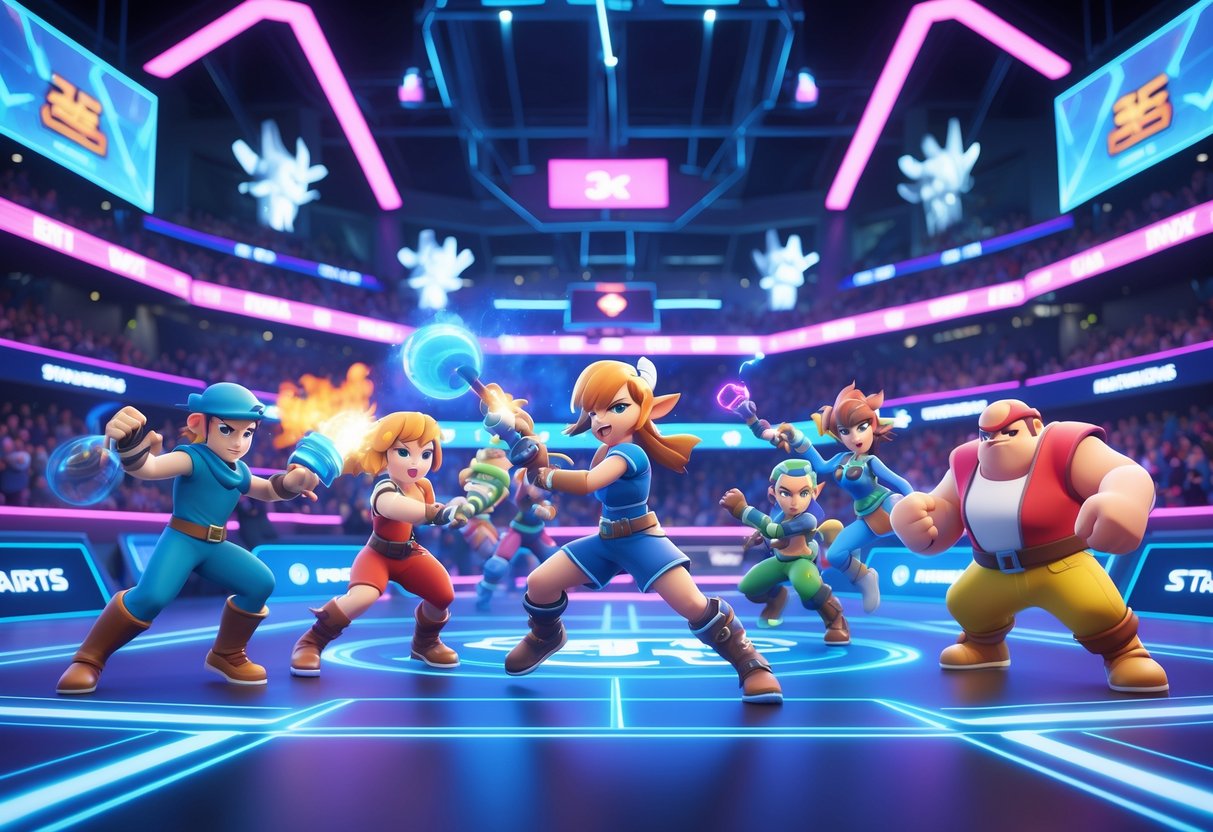
To beat the Championship Challenge, you need 15 wins in five game modes. If you lose three times, you’re out.
You can use every gadget and Star Power you’ve unlocked, so getting ready beforehand matters a lot.
Challenge Structure Explained
The Brawl Stars Championship Challenge uses a 15-0 format split into five sets. Each set brings a different mode, like Gem Grab, Brawl Ball, or Heist.
You face three matches per set before moving on. The maps change from time to time, so memorizing layouts won’t always help.
Every win gets you a Star Drop, which might give you coins, power points, or even brawlers.
As you progress, matchmaking gets tougher. Early rounds are usually chill, but later ones pit you against strong teams.
Three Losses Rule
You’re out after three losses. Every match matters—there’s no slack.
A lot of players lose early because they rush in without prepping. Always check which maps and modes are up before you start.
Quick tip: Take a break if you lose a match or two. Playing tilted leads to bad calls and weak brawler picks.
Think about your team comp. If you queue with randoms, you’ll have a harder time, especially near the end.
With only three losses allowed, playing safe usually works better than trying to show off. Consistency wins challenges.
Using Gadgets and Star Powers
You get access to all gadgets and Star Powers during the challenge, even if you haven’t unlocked them yet. That really levels the field.
Make sure you know which gadget combos work best for your main brawlers. Byron’s healing gadget and Edgar’s speed boost are both popular for a reason.
Pick your Star Power based on the mode. Damage boosts rule in Showdown, but utility powers shine in modes with objectives.
Practice with these setups in regular matches first. The Championship Challenge isn’t the place to try something new and wild.
Don’t assume you know how every gadget works. Some have weird effects that might catch you off guard when it counts.
Understanding Brawlers for the Championship
Picking the right brawler can make or break your run. Each mode wants something different, power levels matter more than you’d expect, and Star Powers can totally change a brawler’s strength.
Brawler Roles and Power Levels
Each brawler fits a specific role, and some just work better on certain maps or modes. Tanks like Frank and Draco crush in Hot Zone, holding space and soaking hits.
Mid-range brawlers like 8-Bit and Lola hold down the center in Gem Grab.
Assassins (think Buzz) are great for picking off gem carriers. Throwers such as Juju and Larry control lanes well in Brawl Ball.
Power level 11 brawlers hit a lot harder than lower-level ones. That extra stat boost can mean the difference in a close fight.
Try to keep at least three brawlers maxed out for each main role. That way, you can adjust when the meta shifts.
Lane control picks like Rico work in more than one mode. His hypercharge is useful in both Gem Grab and Knockout.
Selecting the Best Brawlers
Each stage calls for its own strategy. Gem Grab needs brawlers who can counter tanks and handle aggressive pushes. Rico with vision gear is a top pick.
Brawl Ball rewards speed and control. Stu helps set up fast goals, while Frank anchors your defense.
Heist is all about damage to the safe. Chuck’s teleport is huge here, and Colette or Colt can break the safe in no time.
Hot Zone is best with tanky duos. Barry plus Draco can lock down zones, and Poco’s heals keep them alive.
Knockout punishes mistakes, so you want reliable eliminators. Daryl-Kit-Byron is a strong late-game team, and Rico or Gene are good for countering.
Instead of trying to learn every brawler, just focus on a couple for each stage. Versatile picks save you a lot of stress.
Star Powers and Unique Gadgets
Star Powers can change a brawler’s whole playstyle. Rico’s Super Bouncy makes him a monster on maps with lots of walls.
Penny’s turret gets much scarier with Balls of Fire—great for controlling big areas in Gem Grab.
Gadgets give you clutch options. Chuck’s teleport gadget lets him dodge danger and keep pressure on the safe in Heist.
Buzz’s reserve buoy gives him another shot at big plays, perfect for chasing down gem carriers.
Always check the current meta before each challenge. Star Power value shifts around when new brawlers drop.
Some gadgets only shine in certain modes. Sandy’s sleep gadget is awesome for Hot Zone but not so great in Knockout.
Game Modes in the Championship
The Brawl Stars Championship features five main competitive game modes. Each one tests different skills and asks for its own strategies.
Overview of Available Game Modes
The championship cycles through five game modes: Gem Grab, Brawl Ball, Bounty, Heist, and Knockout. These modes really define competitive Brawl Stars.
Gem Grab is all about grabbing and hanging onto gems that spawn in the map’s center. Teams need to collect 10 gems and hold onto them for 15 seconds to win. If you get taken out, you’ll drop whatever gems you were carrying.
Brawl Ball feels a lot like football, but with more chaos and obstacles. Two teams try to score by kicking a ball into the other team’s goal. Aggressive plays and team coordination usually pay off here.
Bounty puts the spotlight on eliminating opponents to collect stars. The team with the most stars when the timer hits zero wins. You really need to focus on map control and positioning.
Heist splits everyone into attackers and defenders. Attackers try to bust open the enemy safe, while defenders do whatever they can to protect theirs. High-damage brawlers usually steal the show here.
Knockout uses elimination-style rounds. If a brawler goes down, they’re out until the next round. First team to win two rounds grabs the match.
Competitive Mode Selection
Championship maps keep changing, but Supercell always picks maps that support balanced and strategic play.
Each mode pushes teams to use different brawlers. For instance, long-range brawlers like Piper shine on Bounty maps with open lines of sight. Close-range picks like Mortis do better in Brawl Ball’s tighter spaces.
Try practicing on ladder matches before jumping into championship runs. The competitive format lets everyone use all star powers, gadgets, and gear they’ve unlocked. That means skill really shows.
Players need to win 15 matches across all five modes to qualify for online tournaments. You can only lose three matches before getting knocked out, so knowing each mode’s quirks is a must.
Map Rotation and Preparation

Knowing map rotations and prepping for each stage gives teams a real edge. Every map needs specific strategies and smart brawler picks if you want to win.
Analysing Map Types
Map layouts can totally change how you approach a match. Heist maps like Kaboom Canyon have narrow corridors and long sightlines, so high-damage brawlers get a lot of value.
Knockout stages such as Belle’s Rock reward players who position well. These maps barely offer any cover, so long-range brawlers become vital.
Gem Grab maps focus on controlling the middle. Crystal Arcade, for example, hides bushes near the gem spawn, which sets up sneaky ambushes.
Hot Zone stages like Dueling Beetle need area control specialists. Where the zones sit really decides which brawlers to bring.
Brawl Ball maps push you to find new ways to score. Pinhole Punt has walls you can break, opening up fresh routes.
Study each map’s main features before matches. Look out for chokepoints, bush spots, and wall placements that mess with movement.
Preparing for Map Rotations
Championship rotations follow patterns you can learn. Start studying the map pool a few weeks before the tournament.
Practice different team compositions on every stage. Each map needs its own plan and brawler combo.
Set up a preparation schedule that covers all five game modes. Don’t ignore any map type—weaknesses get exposed fast.
Pick versatile brawlers that can handle multiple maps. Crow and Cordelius show up a lot in championship teams because they’re so flexible.
Watch professional matches on the same maps. Pay attention to how top teams move and which gadgets they pick.
Test out different star power combos during practice. Some maps make certain abilities way more useful, even for the same brawler.
Tactics for Winning Each Game Mode
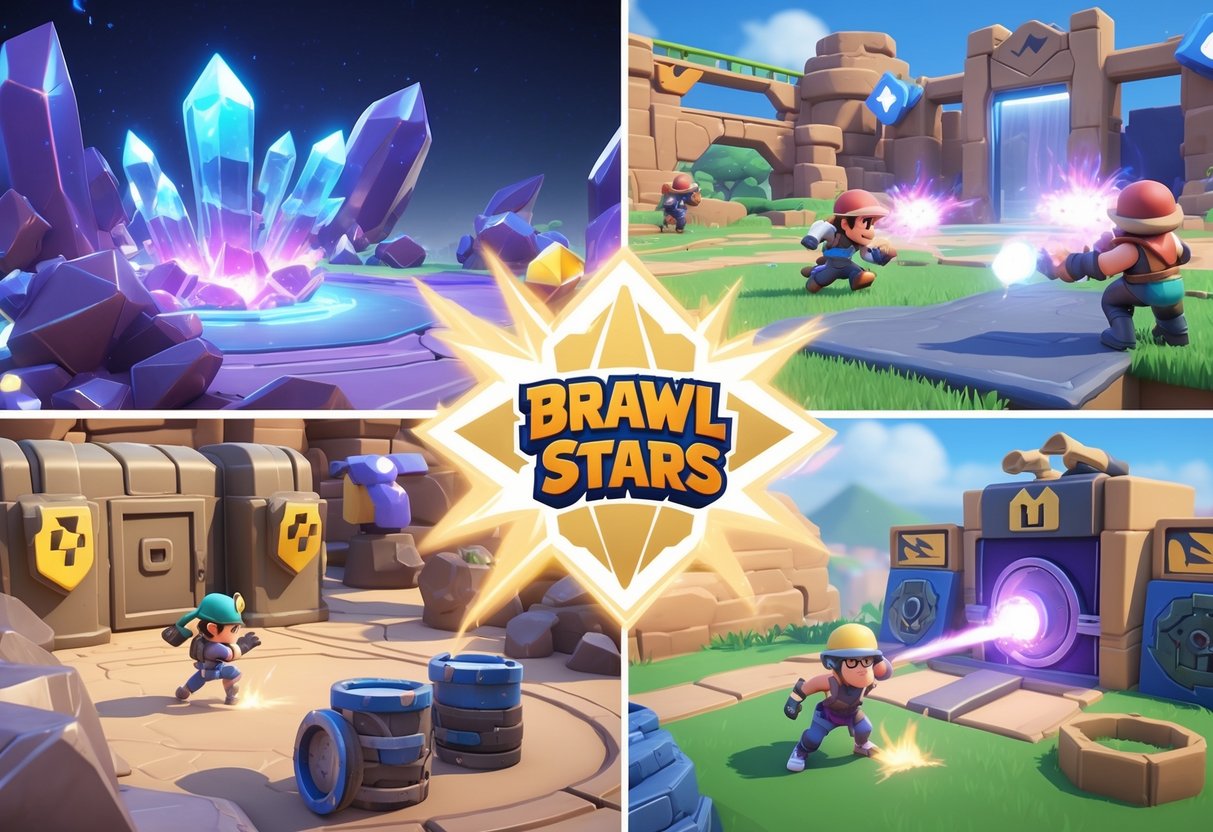
Every mode in Brawl Stars needs its own approach. Control-based modes demand territory management, while objective modes need sharp teamwork.
Brawl Ball Tactics
Team Composition matters a ton in Brawl Ball. You want one tank to punch through enemy lines, one support for healing or crowd control, and a damage dealer to finish fights.
Ball Control is more important than racking up kills. Never chase the ball carrier alone—work with your team to pressure them. If you grab the ball, pass it around instead of always going for the solo score.
Defensive Positioning can win you games. Keep one player near your goal for surprise shots, and let the other two push up—but fall back quick if you lose the ball.
Key Strategies:
- Use tanks like El Primo or Frank to break walls.
- Keep Poco or Sandy for team support.
- Save supers for clutch defensive moments.
- Control the middle of the map.
Quick Tip: Don’t get too obsessed with scoring. Blocking enemy goals matters just as much.
Gem Grab Strategies
Gem Carrier Selection can make or break your run. Pick someone tanky like Sandy or Pam. The gem carrier should avoid direct fights.
Map Control means always keeping pressure on the center. Two players push up while the gem carrier hangs back. Hold the middle but don’t risk it all for a few extra gems.
Countdown Management is where great teams pull ahead. When the countdown starts, the gem carrier hides and teammates create space. Don’t get greedy.
Role Distribution:
- Gem Carrier: Survives, avoids combat.
- Aggro Player: Pushes enemies, opens up space.
- Support: Covers lanes, keeps everyone safe.
Essential Tips:
- Never let the gem carrier die with 10+ gems.
- Use bushes to keep the carrier safe.
- Rotate positions to throw off the enemy.
Heist Approaches
Damage Dealers dominate Heist. Bring brawlers like Colt, Rico, or Nani to melt the enemy safe and still defend your own.
Wall Breaking gives you new attack routes. Use throwers like Dynamike early to open paths, then swap to high-damage brawlers for the final assault.
Defensive Balance is all about timing. Don’t send everyone to attack—leave one player back to defend your safe. Teams often lose by ignoring defense.
Timing Your Push can decide the match. Sync up your team’s supers for one big push instead of trickling in.
Effective Strategies:
- Break walls with a plan, not at random.
- Use long-range brawlers for both offense and defense.
- Save hyper charges for hitting the safe hard.
- Focus on the safe, not just enemy brawlers.
Optimising Teamwork and Communication
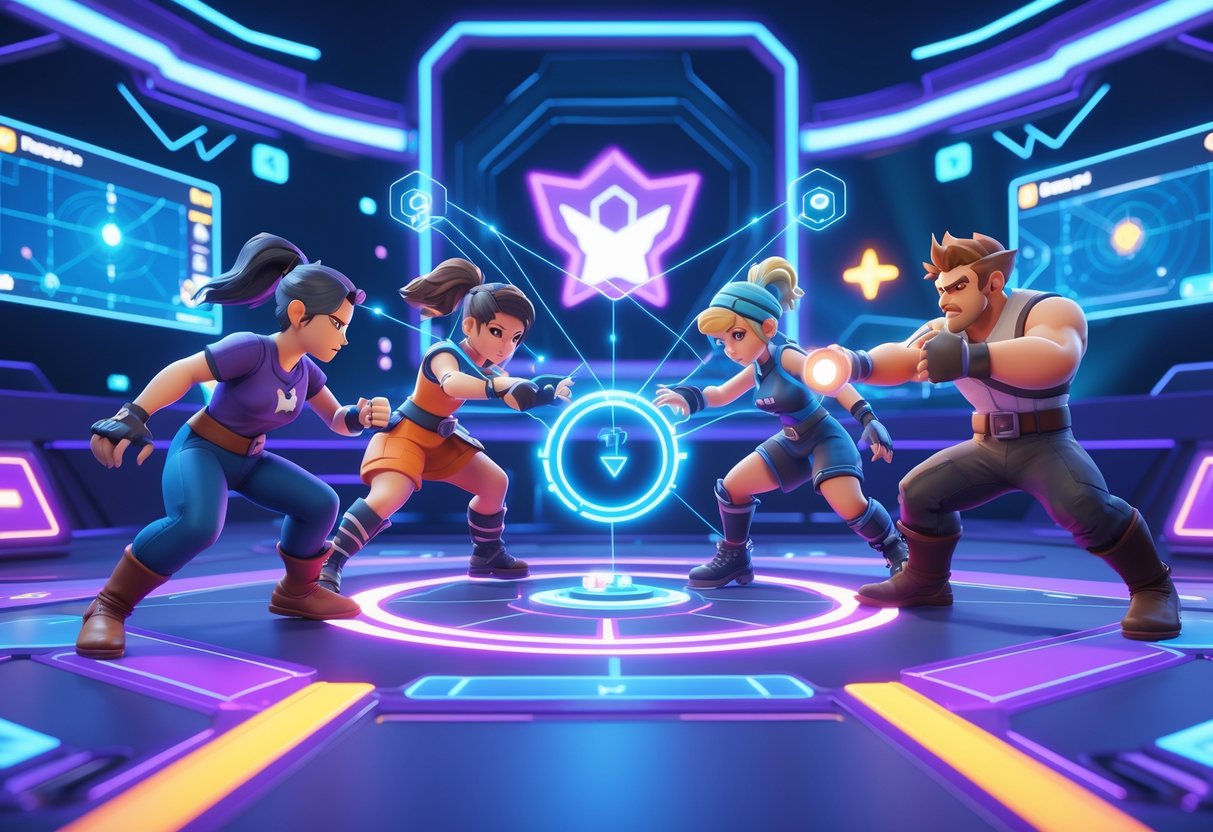
Strong team coordination and smart team picks make the difference between a deep championship run and an early exit. The meta right now demands you adapt to your opponents and keep communication sharp.
Coordinating with Your Team
Voice chat seriously boosts performance. Teams using Discord or similar apps win 40% more than teams that just use in-game emotes.
Set up callout names for map spots before matches. Stick to simple stuff like “left bush,” “mid gem,” or “enemy spawn”—no need to overcomplicate.
Assign roles clearly:
- One player calls enemy locations.
- Another tracks ultimate abilities.
- The third manages team positioning.
During tense moments, keep callouts short. Say “Edgar left” instead of a whole speech about where he’s going.
Practice calling out threats a couple seconds before they hit. That gives everyone time to react.
Between rounds, take 15 seconds to talk about what went wrong. Quick tweaks work better than dragging things out.
Optimising Team Compositions
Meta comps change every month with balance patches. Keep an eye on championship streams and pro players’ socials for the latest.
Build teams around synergy types:
| Synergy Type | Example Brawlers | Best Maps |
|---|---|---|
| Tank + Support | Frank + Poco + DPS | Gem Grab close-quarters |
| Long Range Control | Piper + Brock + Belle | Bounty open maps |
| Aggro Rush | Edgar + Mortis + Fang | Brawl Ball tight spaces |
Counter-picking wins games. If the enemy team goes heavy tanks, draft Shelly or Buzz for tank-busting supers.
Save your strongest team comp for the last rounds. Lots of teams use their best stuff too early and then run out of ideas.
Gadget combos can boost your team. Try Gale’s jump pad with Dynamike’s bombs, or use Max’s speed boost to help slow brawlers get in.
Practice at least three team comps before tournaments. You’ll need backup plans in case your main picks get banned.
Adapting to Opponent Strategies
Spot enemy patterns fast—ideally in the first two minutes. Notice if they love left-side pushes, group fights, or solo flanks.
Switch roles mid-match if your current plan’s not working. Sometimes your gem carrier needs to get aggressive if the enemy is playing too safe.
Track enemy gadgets and supers:
- Watch which abilities they burn.
- Keep an eye on cooldowns.
- Plan your fights around their timings.
Map control shifts need quick reactions. If the enemy grabs mid, try side lanes instead of running into their setup.
Figure out their win condition. Teams building for late-game need early pressure, while aggressive comps can be baited into overextending.
When things aren’t working, suggest clear changes: “Let’s try a 2-1 split” works better than just venting.
Emergency adaptation is easier with pre-planned signals. Agree on callouts like “Plan B” or “Switch” to flip tactics instantly.
Mastering the Championship Meta
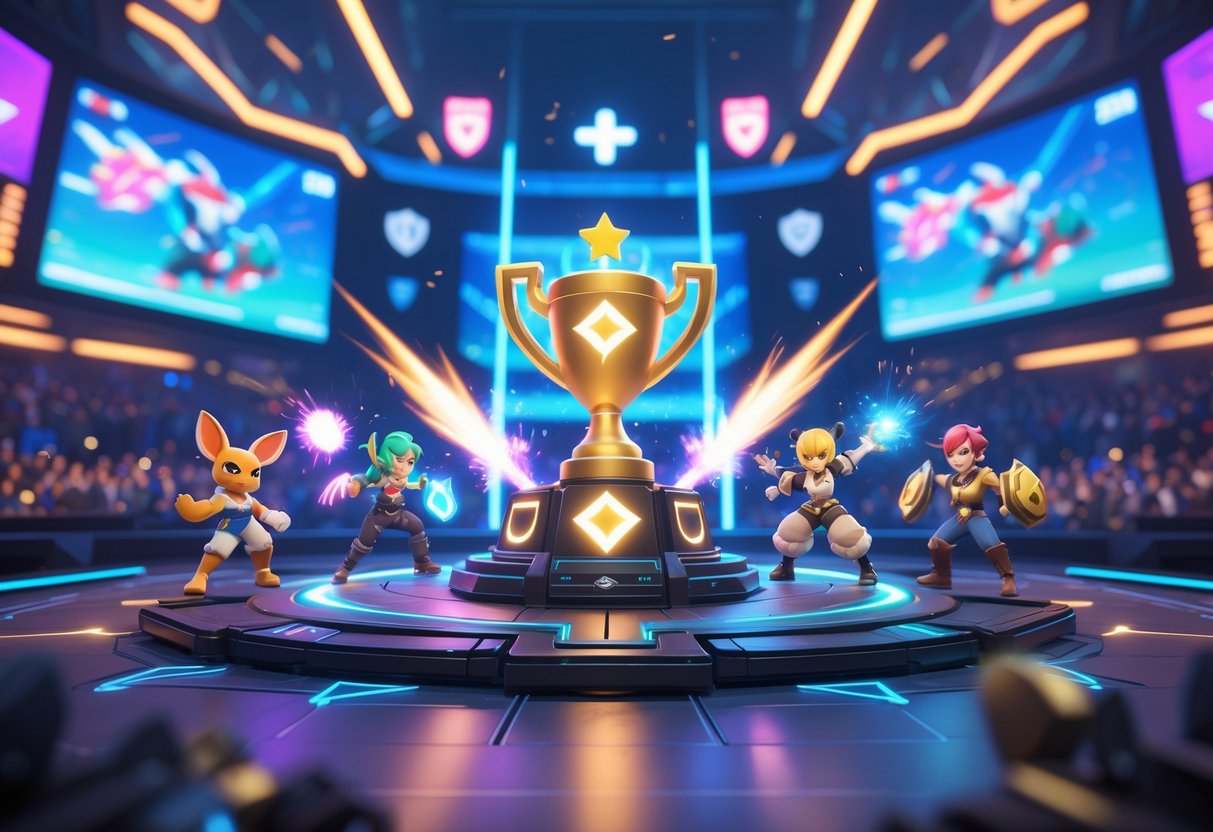
The Championship Challenge meta really revolves around a handful of brawler picks that dominate certain maps. If you learn the top-tier comps and their counters, you’ll have a real edge.
Current Meta Picks
Jesse is the top pick for several maps in rotation. Her bounce shots do serious work on Sneaky Fields and Open Business, so she’s a go-to for a lot of teams.
Sandy works great with Jesse across different modes. Sandy’s sandstorm gives your team bush control and steady support, and his damage is always reliable.
For gem grab on Hard Rock Mine, Gan makes the perfect gem carrier. He’s super mobile and tough to take down, especially with teammates like Rico or Angelo backing him up.
Long-range brawlers just take over on Shooting Stars. Tick, Nani, and Piper can lock down the open map and force enemies into bad spots.
Here’s a quick meta breakdown by map:
| Map | Top Picks | Role Focus |
|---|---|---|
| Sneaky Fields | Jesse, Sandy, BB | Tank counter/control |
| Hard Rock Mine | Gan, Sandy, Rico | Gem control |
| Open Business | Jesse, Sandy, BB | Zone dominance |
| Safe Zone Heist | Colt, Melody, Colette | Safe damage |
| Shooting Stars | Tick, Nani, Piper | Range control |
Counter Strategies
Tank comps can get wrecked by Jesse’s bounce shots, but double tank with Poco still works on bushy maps. It’s worth trying if the enemy goes all-in on squishy brawlers.
Angelo is a great answer to meta picks. His range and burst damage let him challenge Sandy-Jesse teams, especially in gem grab.
Hyper charges totally change the game. Go for brawlers with impactful hyper charges like BB for quick zone grabs or Rico for team fights.
A few fast counter tips:
- Use Mr P with his teleporter gadget to mess with long-range teams.
- Pick 8-bit or Max to break up Jesse comps.
- Try Chuck or Angelo for safe damage if you need something different.
Heads up: Don’t force meta picks if you’re not comfortable. Playing your best brawlers well usually beats using meta picks badly.
Practising and Improving Performance
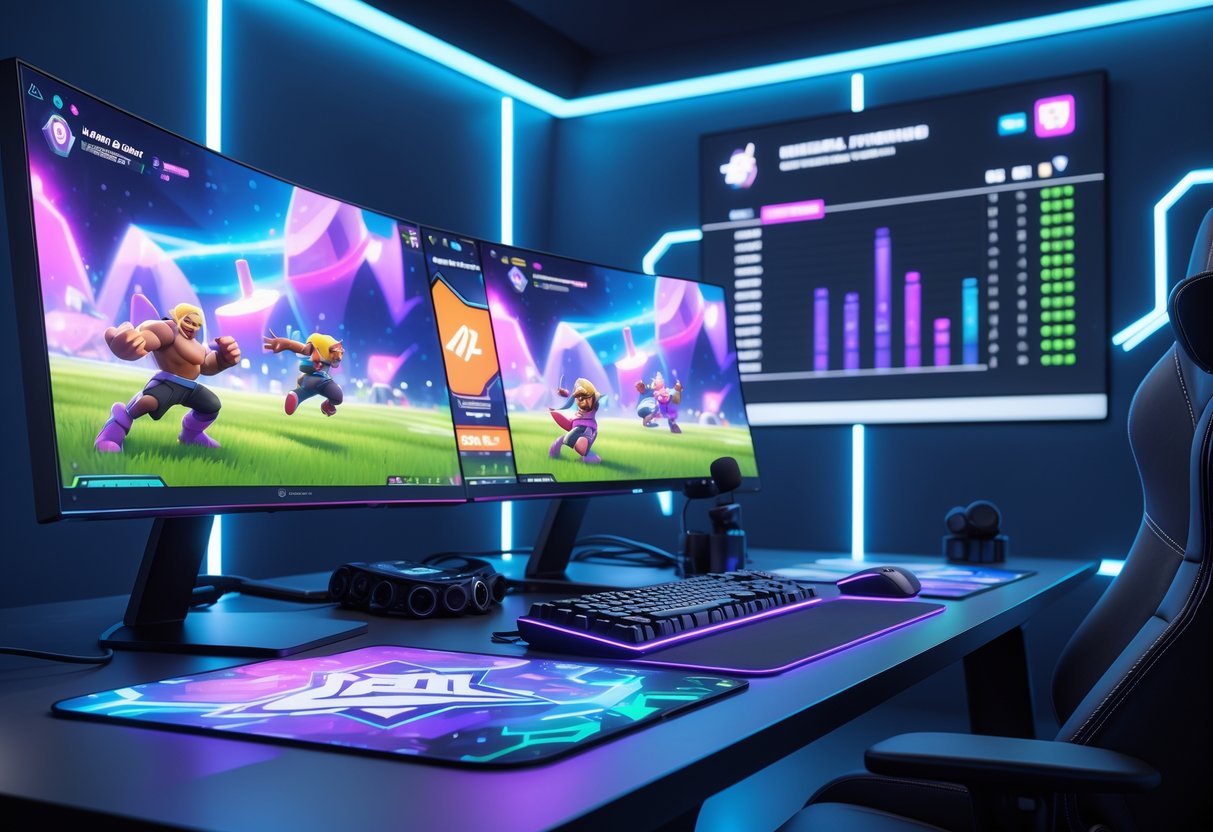
Getting better at competitive Brawl Stars means focused practice and smart match analysis. Build consistent routines that target your weak spots and review your games to spot the patterns holding you back.
Effective Practice Routines
The Training Cave? It’s honestly the best place to warm up or try out new brawlers. I usually spend about 10-15 minutes there before I hop into ranked matches.
Try practicing specific situations—like dodging enemy supers or nailing skill shots. Just pick one brawler per session and really dig into their mechanics.
If you set up custom matches with friends, you can work on team coordination without worrying about losing trophies. Run a few 3v3 scrims to get a feel for positioning and timing.
| Practice Type | Time Needed | Best For |
|---|---|---|
| Training Cave | 10-15 mins | Aim training, new brawlers |
| Custom matches | 20-30 mins | Team strategies |
| Friendly battles | 15-20 mins | Testing builds |
Give the “one-trick” method a shot. Stick with a single brawler for 20 matches in a row. You’ll figure out their strengths and weaknesses way faster than if you keep switching.
Mobile gaming can mess with your aim if you go too long. Keep your practice short and take breaks every 30 minutes or so. Your hands will thank you.
Analysing Matches for Growth
After a rough losing streak, go back and watch your match replays. Instead of blaming teammates, look for moments where you could’ve positioned better or missed a key play.
Focus on three things: positioning, timing, and target priority. Ask yourself why you died and what you could’ve done instead.
Pro tip: Jot down your biggest mistakes in a notes app. After 10-15 matches, you’ll start to notice patterns.
Check out Brawl Stars Championship footage. Watch how pros move during team fights and when they decide to engage.
Pay close attention to map control. Good players don’t chase kills into bad spots—they let enemies mess up first.
Compare your gameplay to players one rank higher. See how they use cover and manage ammo. It’s eye-opening.
Rewards and Progression in the Championship
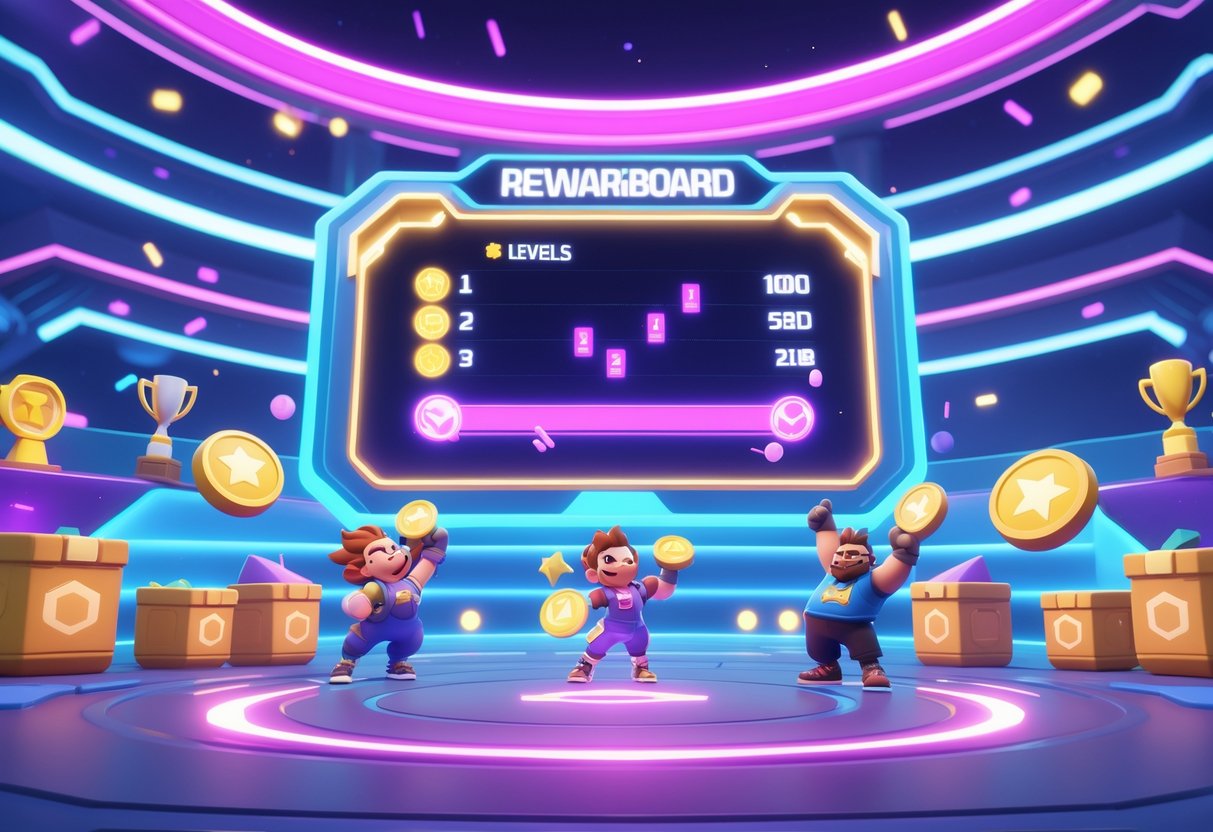
The Championship Challenge gives out 15 random Starr Drops if you win 15 times across five stages. Each win gives you instant rewards that help your account progress faster than regular play.
Earning Star Points and Brawl Boxes
Star Drops are the core of Championship Challenge rewards. Every victory hands you a Starr Drop—these can be coins, power points, or sometimes rare brawlers.
If you manage the 15-0 run, you’ll get a big account progression boost. Most players say these rewards are worth weeks of casual play.
Here’s how rewards break down:
- Early wins (1-5): Just coins and power points
- Middle wins (6-10): Better loot, sometimes gadgets
- Final wins (11-15): Premium stuff like star powers and brawlers
Honestly, it’s better to prioritise these challenges over normal matches. The rewards are just that much better for your time.
Quick win: Even if you don’t go 15-0, every win still gives you something useful for your account.
Unlocking Advanced Stages
Championship progression runs on a stage-based system with five phases. Each stage has different modes and maps, so you need to adapt your tactics.
As you move up, you’ll face tougher opponents. Early stages feel pretty chill, but later on you’ll run into players using top-tier strategies.
Stage requirements look like this:
- Stages 1-2: Any brawler comp can work
- Stages 3-4: You really need meta picks
- Stage 5: Team coordination has to be on point
Heads up: If you lose three times, you’re out—no matter which stage you’re on.
The last stages usually include Gem Grab, Brawl Ball, and Bounty. Practice these modes ahead of time to boost your chances.
Most top players plan out different brawler strategies for each stage instead of sticking with one team.
Frequently Asked Questions
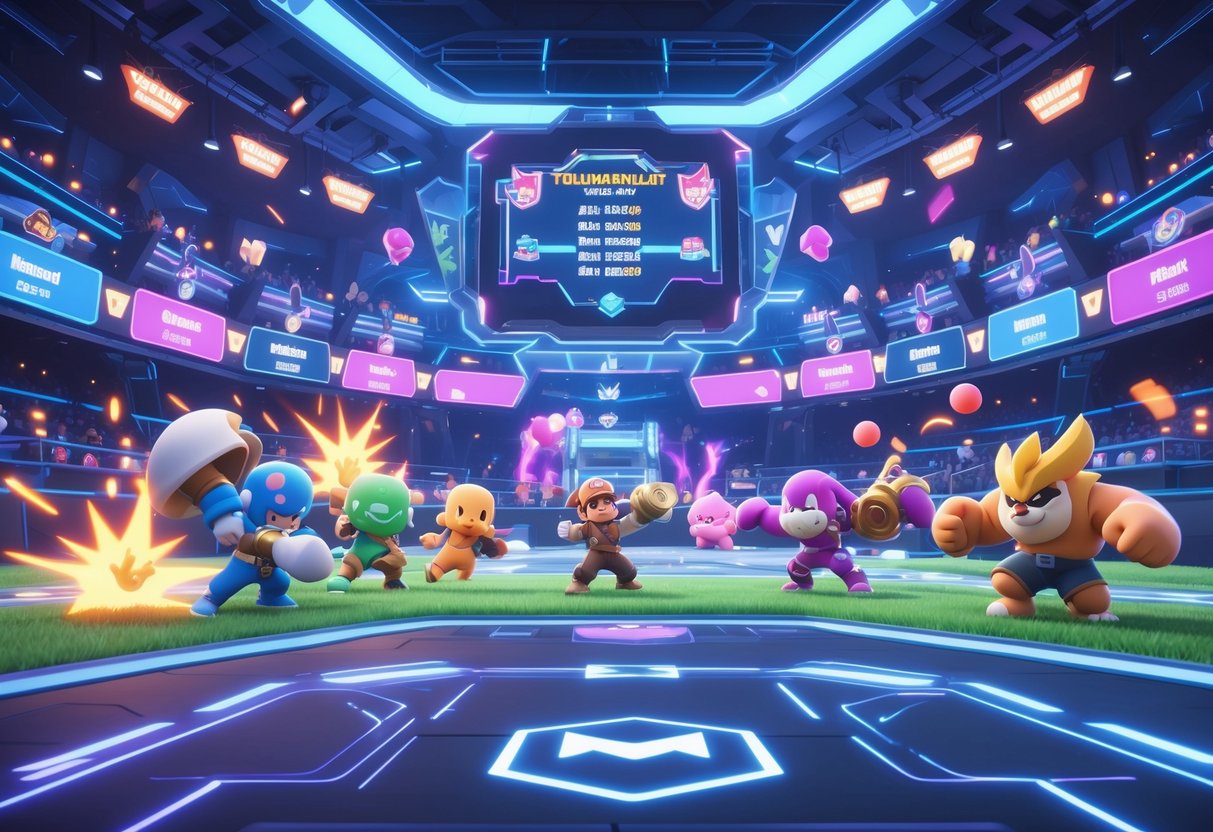
If you want to succeed in championships, you need smart team comps, clear communication, and the ability to keep your cool. Mastering these basics—and staying up-to-date with the meta—gives you the best shot at consistent tournament performance.
What are the top strategies for winning Brawl Stars championships?
Focus on map control and team coordination, not solo heroics. The best teams grab key spots early and force mistakes from their opponents.
Lane control is huge in competitive play. Brawlers like Rico or Frank can dominate their lanes while teammates hold down the rest.
Counter-picking matters more than forcing your favorites. Study what your opponents like to play and prep counters for common strategies like tank rushes or long-range poke.
Quick win: Practice one solid comp for each mode instead of spreading yourself thin.
How do you effectively build a team for competitive play in championships?
Start with teammates who talk things out and stay calm. Fancy skills don’t mean much if your team falls apart under pressure.
Pick players with different brawler specialties. Maybe one loves tanks like Frank, and another shines with long-range picks like 8-Bit or Colt.
Stick to specific roles in practice. The best teams know exactly what each player will do in any situation.
Set up at least three practice sessions a week. Teams that only play together at tournaments usually lose to better-prepared squads.
Can you suggest some tips for mastering the use of Brawler abilities during tournaments?
Nail the timing of your Super abilities. A lot of tournament games are lost because someone panics and wastes their Super.
Work on ability combos with your team in scrims. Pulling off moves like Gene’s pull into a Frank stun can win matches outright.
Learn the cooldowns for both your team and your usual opponents. If you know when enemies are vulnerable, you can press the advantage.
Heads up: Try not to use abilities defensively unless you have to. Going on the offensive with Supers often wins more rounds.
What’s the best way to stay updated with the current meta for championship rounds?
Follow pro tournament results and see which brawlers show up the most. The meta in championships often isn’t the same as in casual games.
Watch recent tournament streams, not just random gameplay. Pros show you how to use the best picks in real matches.
Join Brawl Stars Discord or Reddit communities where players break down balance changes and new strategies. These groups usually spot meta shifts early.
Test out new comps right after balance updates. Teams that adapt fast get a big edge.
How important is communication in team matches, and what are the best practices?
Clear comms win more games than flashy plays in championships. Teams with average skills but great coordination often beat more talented squads.
Use specific callouts like “Frank pushing left lane” instead of vague stuff like “they’re coming.”
Pick a shot-caller before matches. Someone needs to make the final call in tense moments.
Practice your communication during scrims, not just tournaments. Good team talk doesn’t just happen—it takes work.
What are some common mistakes to avoid in high-stakes championship matches?
Don’t chase low-health enemies into risky spots. Championship teams love to punish anyone who overextends, and they’ll quickly turn your mistake into their advantage.
Try not to let frustration take over after an early loss. I’ve seen so many teams throw away winnable matches just because they let their emotions get the best of them and forget their game plan.
Don’t mess around with new brawlers or team compositions in big matches. Stick with what your team knows and has practiced—now’s not the time for experiments.
Forget about individual stats in team games. When players care more about their own numbers than the team’s goals, they almost always end up losing the championship.

